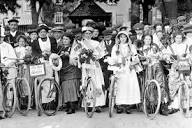I have cycled to and through places that stirred up seemingly-conflicting emotions in me. For instance, during my recent trip to Japan, I pedaled to temples, shrines, gardens and other places with great beauty and terrifying histories. The Nijo Castle in Kyoto was one such spot: It is wonderful to behold and can teach so much about Japanese culture and history, including the fierce battles and brutal ways in which rival families and groups vied for, and held, power. I also felt awe and terror all over Osaka, which the Allies bombed heavily during World War II. (Kyoto, in contrast, wasn’t as much of a target because it didn’t have the military-related industries found in other Japanese cities.)
I similarly felt awed by the beauty and devastation of Cambodia and Laos where, as a legacy of the Vietnam War, there is said to be more unexploded ordnance per square mile, kilometer or whatever unit of measurement you choose, than anywhere else on Earth.
And I could write more posts, possibly even a book, about former battlefields of France and other European countries I saw during my bike trips, not to mention the Place de la Concorde: Today it’s one of the most elegant public squares in the world, but contemporary accounts describe “rivers” of blood flowing from the guillotines stationed there during the Reign of Terror.
I got to thinking about that today. While not an official holiday, this date—“Pearl Harbor Day”—was, until fairly recently, marked by parades and other commemorations to the attack on the American naval base.
While such memorials still take place, they aren’t as numerous or prominent as they were, say, in 1991 (the 50th anniversary) or even twenty years ago because there are so few survivors of the attack or World War II generally.
From what I have read, there is a very popular bike lane that passes the attack site and offers beautiful views of mountains, ocean and rain forest. Were I to ride it, I probably would have a similar combination of thoughts and feelings to what I experienced in Japan, Southeast Asia, France, Belgium, Italy and even some sites (the World Trade Center, anyone?) in and around New York City, where I live.
But I probably won’t ride the Pearl Harbor bike lane because I have never had any desire to go to Hawai’i. Any time I’ve ever embarked upon a journey (Doesn’t that sound quaint?) to some faraway place, one of my friends insists that I should go to Aloha land. I can’t explain why I’ve not only never had any wish to step off a plane in Honolulu; I have actively resisted going there. Something about it just scares and repels me. ( It has nothing to do with Pearl Harbor.) I understand that Anthony Bourdain had a similar feeling about Switzerland, where he never set foot in spite of spending considerable time—and hosting episodes of his show—in the surrounding countries (France, Italy, Germany and Austria). Could I, one day, find that I’ve cycled all around the Pacific Rim while skipping Hawai’i?



















.webp)











